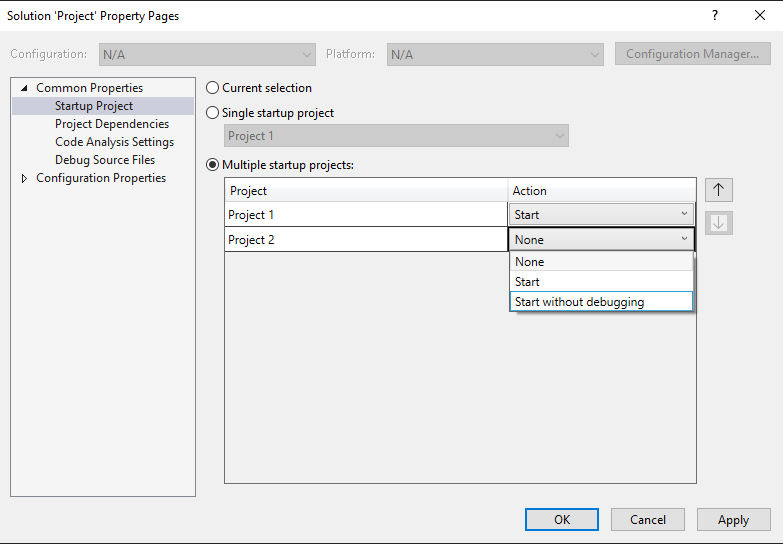Difference between revisions of "GPU621/Debugging OpenMP"
(→Setup) |
(→Setup) |
||
| Line 46: | Line 46: | ||
# Right-click the solution in the Solution Explorer and select Properties. | # Right-click the solution in the Solution Explorer and select Properties. | ||
# In the Properties window, select Common Properties > Startup Project. | # In the Properties window, select Common Properties > Startup Project. | ||
| − | |||
# Here you can change the Startup Project to either the currently selected project, a single startup project (this is selected by default), or multiple startup projects. | # Here you can change the Startup Project to either the currently selected project, a single startup project (this is selected by default), or multiple startup projects. | ||
## When selecting Multiple startup projects, you can modify the execution order and action for each project between Start, Start without debugging, or None. | ## When selecting Multiple startup projects, you can modify the execution order and action for each project between Start, Start without debugging, or None. | ||
# Save your settings by selected Apply or OK. | # Save your settings by selected Apply or OK. | ||
| + | |||
| + | [[File:Startup-settings.png]] | ||
= User Interface = | = User Interface = | ||
Revision as of 01:08, 29 November 2022
Group Members
// TODO: Create a tutorial on how to debug parallel programs using OpenMP in Visual Studio
// remember to add pictures if possible
// Steps
1. Read the Microsoft Documentation for your section
2. Paraphrase the contents of your section onto the Wiki
3. Test it yourself in Visual Studio and add examples
// Uploading Files
To upload a file, go to https://wiki.cdot.senecacollege.ca/wiki/Special:Upload
To include a file in a page, use [[File:File.jpg]] to use the full version of the file
Process and Thread
Process
A process is an instance of a program executed by the computer. Processes are started when programs are initiated, and they can be comprised of one or more threads.
On Windows operating systems, you can look at your running processes on the Task Manager.
Thread
A single thread is a set of instructions that the CPU schedules and executes independently. A process consists of one or more threads which are able to be run concurrently. This forms the basis of multithreading.
Multiple Processes
Background
Visual Studio supports the creation of solutions with multiple processes. Visual Studio's debugger will by default run the first project (selected in bold), but this can be changed in the Solution Explorer by right-clicking on a different project and selecting Set as Startup Project. This will allow you when debugging to switch between processes, as well as break, stop, and continue currently debugging processes.
Setup
To set the startup project or multiple projects:
- Right-click the solution in the Solution Explorer and select Properties.
- In the Properties window, select Common Properties > Startup Project.
- Here you can change the Startup Project to either the currently selected project, a single startup project (this is selected by default), or multiple startup projects.
- When selecting Multiple startup projects, you can modify the execution order and action for each project between Start, Start without debugging, or None.
- Save your settings by selected Apply or OK.
User Interface
// TODO: Show the window and explain what it does for every single window below (medium)
// documentation for windows are here: https://learn.microsoft.com/en-us/visualstudio/debugger/debug-threads-and-processes?view=vs-2022
Attach to Process Dialog Box
Process Window
Thread Window
Source Window
Debug Location Window
Parallel Stacks Window
Parallel Tasks Window
Parallel Watch Window
Walkthrough
// TODO: Step-by-step walkthrough on how to debug program with the specific window
// use same program for both tests
// can probably just take something from course notes and modify it to fit our parameters
Case A: Using the Thread Window
// TODO: walkthrough on using thread window to debug (medium)
Case B: Using the Parallel Stacks Window
// TODO: walkthrough on using parallel stacks window to debug (long)
